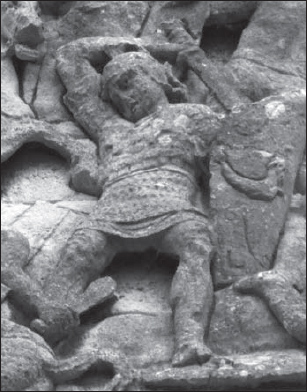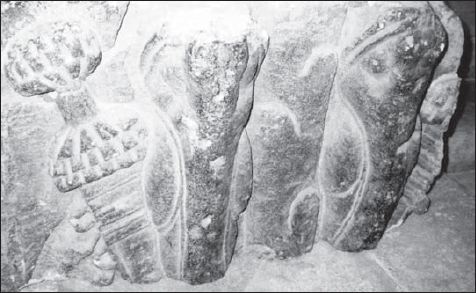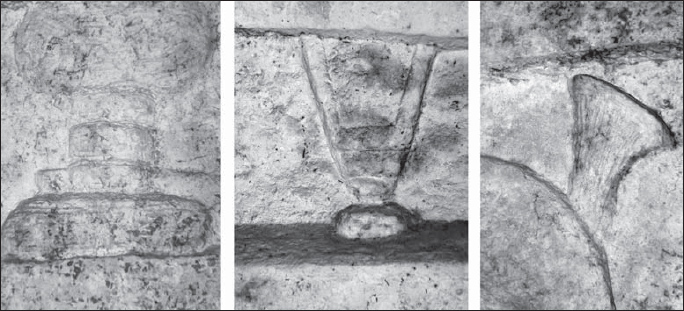
Men-at-Arms • 479
The Classical and Late Empire

Raffaele D’Amato • Illustrated by Giuseppe Rava
Series editor Mar tin Windrow
INTRODUCTION
ORGANIZATION
CAREERS
RISKS & REWARDS
SOCIAL STATUS
ARMS & EQUIPMENT
CLOTHING & DISTINCTIONS
SELECT BIBLIOGRAPHY
PLATE COMMENTARIES
For the safety of the Emperor, the vow that I,
Lucius Maximus Gaetulicus, son of Lucius,
of the tribe Voltinia, from Vienna, made
as a new recruit in Legion XX Valeria Victrix
– to Imperial Victory, All-Divine and Most Reverend –
I have now fulfilled as chief centurion of
Legion I Italica, in the consulship of Marullus
and Aelianus, after 57 years of service
(Inscription of AD 184 from Novae in Lower Moesia – modern Bulgaria)
I wanted to hold slaughtered Dacians. I held them.
I wanted to sit on a chair of peace. I sat on it.
I wanted to take part in famous triumphs. It was done.
I wanted the full benefits of a chief centurion. I have had them.
I wanted to see naked nymphs. I saw them.
(Inscription from Africa by anonymous veteran of Trajan’s Dacian Wars – AE, 1928, 27)
When an imperial Roman soldier signed his contract for 25 years of military service, his greatest ambition was to become a centurion – the most experienced, reliable and admired class of officers in the Roman military machine. The senior officers who commanded and staffed Roman formations were essentially non-specialists, with little or no formal training, so the army relied upon the centurions for the crucial level of command between the military tribunes and the common soldiers. In modern terms, we might characterize the legionary centurionate as a large and stratified organization of ‘warrant officers’, holding all appointments between platoon and battalion commands. It was these professional fighting men – sometimes with as much as 20 years’ experience under their belt – who maintained day-to-day training, discipline and organization, and who provided personal tactical leadership in battle.

A fighting centurion of Legio II Augusta, from the Arc d’Orange in southern France, 29 BC or AD 21; see Plate A2 for reconstruction. (in situ; author’s photo)
Many of these elite combat officers were destined to rise to more senior posts in the army, and later in the civilian administration, and in the process they transformed the social status and wealth of their families. The serving and former senior centurions of the legions were a group enjoying considerable influence both within and beyond the armies, and on occasions members of this class were instrumental in setting up and casting down Emperors of Rome.
In this necessarily short work, following my Men-at-Arms 470 on centurions of the pre-Augustan periods, I have assembled only a selection of the many references to centurions left to us by ancient writers; my aim is to give a general idea of their place in military and civil society, of their military careers, and of their equipment. Details of their regular duties and tactical leadership are not repeated here from MAA 470, in order to leave space for other material. For the same reason I have not touched here upon the centurions of the Imperial Fleets – for which see my MAA 451, Imperial Roman Naval Forces 31 BC–AD 500– and only very briefly on the Late Roman officer rank of centenarius.
In the early 1st century AD a single legion was usually composed of 60 centuriae, with a complement of about 5,240 men. Three or more centuriae (six, according to Pseudo-Hyg., De Mun. Castr. I, 7, 1, 30) were formed into a cohors, a unit of about 240–500 men (Josephus, BJ, 15, 6; Pseudo-Hyg., De Mun. Castr. I, 2); the legion was thus divided into ten cohorts. The centuria was the basic sub-unit, usually of 80 milites gregarii, under the centurio (Josephus, BJ, I, 4,3; hekatontarchês in the eastern part of the empire, BJ, VI, 1, 8). However, Martial specifically mentions a centurion who led 100 men (Ep., X, 26). Each centuria was further divided into ten contubernia – tent and messing squads.

Bronze gorgoneion or Medusa mask, 1st century AD, as visibly applied to the breast of the ringmail shirt worn by the centurion on the Arc d’Orange – see page 3. Originally the eyes and mouth were painted in white and red, giving it an even more striking appearance – it should be remembered that in Classical mythology, those who faced the gorgon’s stare were turned to stone. (Museo Archeologico Nazionale, Este; author’s photo, courtesy of the museum)
The precedence of units and sub-units within the legion reflected the order of march or advance. The First Cohort, cohors prima, had twice the number of men (Pseudo-Hyg., De Mun. Castr. III), so it was usually 800–1,000 strong; during the 1st century AD it consisted of five, not six, double-sized centuriae,commanded by centurions termed collectively as primi ordines (thus giving the legion a total of 59 rather than 60 centurions). Within all cohorts the centurions’ titles of appointment still reflected the three old troop-types of the Consular legion – the hastati, principi and pili. The Second to Tenth Cohorts each had six centurions, titled, from junior to senior, as the hastatus posterior, hastatus prior, princeps posterior, princeps prior, pilus posterior, and pilus prior. The number of the cohort prefixed each of these titles; e.g., the nonus hastatus posterior commanded the second of the two centuriae of hastati – and was thus the most junior centurion – within the Ninth Cohort.
Within the primi ordines the ascending order of superiority was hastatus posterior, princeps posterior, hastatus, princeps, and primus pilus. These First Cohort centurions outranked all centurions of the other cohorts. The primus pilus (‘first javelin’) was the senior centurion in the whole legion (Mart., Ep., I, 31; 93). He commanded the senior (front, or right-hand) centuria within the First Cohort, and thus that whole cohort. Only eight officers in a fully-officered legion outranked the primus pilus: the legate (legatus legionis) commanding the legion; his second-in-command, the senior tribune (tribunus laticlavus); the camp prefect (praefectus castrorum); and the five other tribunes (tribuni angusticlavii), who apparently served as staff officers to the legate.

A centurion’s sword of Mainz type, and decorated greaves, from a lost monument in Avignon dating from the 1st century BC or 1st century AD. (Musée Calvet, Avignon; author’s photo, courtesy of the museum)
The term centuriones ordinarii (SHA, Firm. XIV, 2) was applied to centurions actually in command of centuries, as opposed to those detailed for detached service – e.g. on the staff of a governor, in the Praetorian Guard, or commanding independent, non-legionary units. Each centurion, however senior, had his own allocated centuria; this was a self-contained sub-unit, and was identified by the centurion’s name. The tents of the ten contubernia making up a century were grouped together in the marching camp, and in permanent posts each centuria had its own accommodation in a barrack block – usually ten double rooms, with the century office and the centurion’s living quarters at the end. Writing of Vespasian’s army, Josephus (BJ, III, 5, 3) stated that ‘their times also for sleeping and watching and rising are notified beforehand by the sound of trumpets, nor is any thing done without such a signal; and in the morning the soldiers go every one to their centurions, and these centurions to their tribunes, to salute them’.
The term principales indicated all men ranking between the common milites gregarii and the centurions – roughly, what we would call ‘noncommissioned officers’. Within each centuria they comprised the signifer (standard-bearer – in the century of the primus pilus, the aquilifer or eagle-bearer); the optio (the centurion’s second-in-command); the cornicen and bucinator (hornist and trumpeter); and the tesserarius (administrative assistant – what we might call the ‘orderly room clerk’).
The non-citizen auxilia or auxiliary units made up approximately half of the Roman army, and were organized in infantry or mixed cohortes and cavalry alae. These separate units of c. 500 or c. 1,000 men were usually commanded by a tribune or a prefect – ranks reserved for men of the superior ‘equestrian’ social class, which was defined by proven wealth – but they relied for the maintenance of discipline, training and tactical leadership upon centurions or decurions, who enjoyed the same status as legionary centurions. The auxiliary centurions were mainly promoted from the ranks (or, especially in the 1st–2nd centuries AD, from among principales) of the legions. In a minority of cases centurions and decurions were entrusted with the command of some of the auxiliary units (CIL, III, 1918, 8739, 11936, 14370 2; VII, 371), and apparently without entirely losing their connection with their parent legion (CIL, II, 4083, 4114; III, 7904; VIII, 2749). There is mention of the secondment of a centurion from Legio X Fretensis to Britain as praepositus cohortis prima hispanorum – Commander of the First Cohort of Spaniards; this may have been at the time of the major campaign led by the Emperor Septimius Severus (r. AD 193–122 – CIL, VII, 371). When, atypically, a centurion was transferred from a legionary appointment to a unit command in the auxiliary troops, this was no real promotion; the man performed the duties of unit commander, but his rank remained that of centurion.

Details from the funerary stele of L. Blattius Vetus, a centurion of Legio IIII (IV) Macedonica, dated to the end of the 1st century BC; see Plate A1. One side of the stele (left) displays his dona militaria, which under close examination can be identified as two torques and nine phalerae. The other side shows, protruding from behind a curved scutum shield, the scabbard chape of a gladius sword of Mainz type (centre), and the end of a vitis vine-staff (right). The latter is intriguingly carved in the Egyptian lotus-flower shape – this identifies Blattius as a veteran of Augustus’s campaign in Egypt – and may also have been painted. Interestingly, the stele is also carved with only a single greave (ocrea), perhaps echoing the traditional Samnite style of wearing a greave on the left leg only. (Archaeological Museum, Este; author’s photo, courtesy of the museum)
In the 2nd and the first part of the 3rd century AD, centurions were also detached from their legions and assigned as praepositi (commanders) of more temporary independent native units (numeri) that we might term ‘frontier scouts’. For example, many inscriptions from the North African fort of Calceus Herculis (El Kantara) relate to a centurion who was sent to command either a Numerus Palmyrenorum or, less probably, a centuria of Legio III Augusta stationed there (AE 1926.144–145; 1933.42; CIL VIII, 2497–2498). Another inscription mentions that during the reign of Commodus (r. AD 180–192) a police post (burgus speculatorius) was established for the safety of travellers at a road junction on the route between Calceus Herculis and Mesarfelta, and was commanded by a centurio praepositus of the Numerus Hemesenorum. (CIL, VIII, 2494–2495). At a later period centurions given some independent staff appointments may have been permanently detached from their legions (CIL, VIII, 7050).
The emperors’ Praetorian cohortes of the imperial "bodyguard had their centuriae and centuriones (Suet., Nero, 47). The term of service in these cohorts was 16 years, and on completion of this period the most efficient soldiers were invited to continue their service indefinitely, with increased pay and rank, as evocati. This was a regular status, giving access to a range of possible employments; many – though not all – evocatiwere either ex-centurions, or would later be promoted to that rank.
Originally Rome had three cohortes urbanaevigilespraefectus vigilum,princeps,